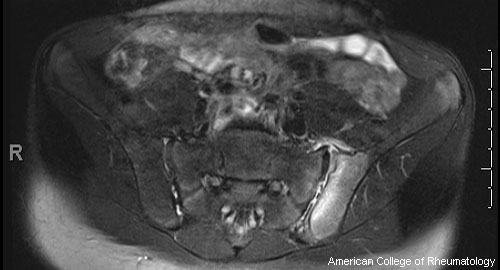 Researchers have begun to recognize a connection between gut microbiota and spondyloarthritis (SpA), such as enthesitis-related arthritis (ERA)/juvenile idiopathic arthritis (JIA). Matthew L. Stoll, MD, PhD, a pediatric rheumatologist at the University of Alabama in Birmingham, and colleagues published the results of their investigations of the relationship between microbiota and ERA online on Oct. 27 in Genes and Immunity. The group has previously shown that patients with ERA have alterations in the composition of their gut microbiota relative to healthy patients. In the current study, they sought to better understand how an altered microbiota might predispose patients to arthritis. Thus, they performed metabolic profiling of fecal samples of children with ERA.
Researchers have begun to recognize a connection between gut microbiota and spondyloarthritis (SpA), such as enthesitis-related arthritis (ERA)/juvenile idiopathic arthritis (JIA). Matthew L. Stoll, MD, PhD, a pediatric rheumatologist at the University of Alabama in Birmingham, and colleagues published the results of their investigations of the relationship between microbiota and ERA online on Oct. 27 in Genes and Immunity. The group has previously shown that patients with ERA have alterations in the composition of their gut microbiota relative to healthy patients. In the current study, they sought to better understand how an altered microbiota might predispose patients to arthritis. Thus, they performed metabolic profiling of fecal samples of children with ERA.
The investigators collected fecal samples from two cohorts of children with ERA: the first included children who had a relatively new diagnosis of JIA/ERA and the second included children with more long-standing JIA/ERA. The team used nano-liquid chromatography-mass spectrometry (LC-MS) to analyze the metabolomics of fecal water homogenates. They identified metabolites based on mass charge ratios.
Their research represents the first metabolomics analysis of the gut microbe communities found in patients with SpA. The researchers identified 1,500 negatively charged ions in the first cohort and found that 154 of them were lower—and one higher—in the patients with ERA. The analysis of the second cohort revealed that many of the negatively and positively charged ions were under-abundant in patients relative to controls, with only two being over-abundant. In both cohorts, patients had a lower diversity of ions and an underrepresentation of multiple metabolic pathways, including the tryptophan metabolism pathway. Specifically, when the investigators combined their analysis of the positively and negatively charged ions in patients with arthritis, they found that 21 unique tryptophan metabolites accounted for the underrepresentation of the tryptophan metabolic pathway.
To determine which organisms were responsible for the metabolomic differences, the investigators sequenced the 16S ribosomal DNA of patients in the first cohort. They then performed a Phylogenetic Investigation of Communities by Reconstruction of Unobserved States (PICRUSt) on the 16S sequence data. Although they found differences in gut metabolomics diversity between patients and controls, they did not find striking differences at the taxonomic level in the microbiota of the two populations. However, they did find that the microbiome of patients with ERA had significantly fewer microbial genes associated with metabolic processes in patients as compared with controls.
Thus, children with ERA appear to have lower levels of tryptophan metabolites relative to controls. The differences in metabolites appear to be attributable to differences in the gut microbiota. Tryptophan is metabolized into ligands of the aryl hydrocarbon receptor, which is associated with the generation of pro-inflammatory cytokines. In this way, the fecal microbiota of patients with ERA may contribute to their pro-inflammatory phenotype.



